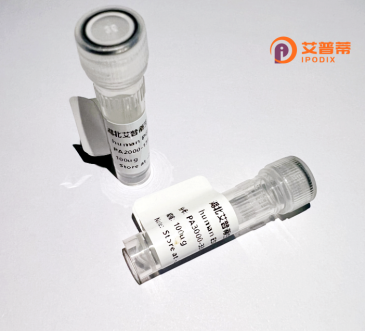
| 纯度 | >90%SDS-PAGE. |
| 种属 | Human |
| 靶点 | KLKB1 |
| Uniprot No | P03952 |
| 内毒素 | < 0.01EU/μg |
| 表达宿主 | E.coli |
| 表达区间 | 20-390aa |
| 氨基酸序列 | GCLTQLYENAFFRGGDVASMYTPNAQYCQMRCTFHPRCLLFSFLPASSINDMEKRFGCFLKDSVTGTLPKVHRTGAVSGHSLKQCGHQISACHRDIYKGVDMRGVNFNVSKVSSVEECQKRCTNNIRCQFFSYATQTFHKAEYRNNCLLKYSPGGTPTAIKVLSNVESGFSLKPCALSEIGCHMNIFQHLAFSDVDVARVLTPDAFVCRTICTYHPNCLFFTFYTNVWKIESQRNVCLLKTSESGTPSSSTPQENTISGYSLLTCKRTLPEPCHSKIYPGVDFGGEELNVTFVKGVNVCQETCTKMIRCQFFTYSLLPEDCKEEKCKCFLRLSMDGSPTRIAYGTQGSSGYSLRLCNTGDNSVCTTKTSTR |
| 预测分子量 | 43.4kDa |
| 蛋白标签 | His tag N-Terminus |
| 缓冲液 | PBS, pH7.4, containing 0.01% SKL, 1mM DTT, 5% Trehalose and Proclin300. |
| 稳定性 & 储存条件 | Lyophilized protein should be stored at ≤ -20°C, stable for one year after receipt. Reconstituted protein solution can be stored at 2-8°C for 2-7 days. Aliquots of reconstituted samples are stable at ≤ -20°C for 3 months. |
| 复溶 | Always centrifuge tubes before opening.Do not mix by vortex or pipetting. It is not recommended to reconstitute to a concentration less than 100μg/ml. Dissolve the lyophilized protein in distilled water. Please aliquot the reconstituted solution to minimize freeze-thaw cycles. |
以下是关于KLKB1重组蛋白的参考文献示例(注:以下内容为示例,实际文献需通过学术数据库检索确认):
---
1. **文献名称**: *"Recombinant human plasma kallikrein: production, purification, and functional characterization"*
**作者**: Smith A, et al.
**摘要**: 本研究报道了通过哺乳动物表达系统成功表达并纯化重组人源KLKB1蛋白,验证其酶活性及在体外凝血和缓激肽生成中的功能,为研究KLKB1的病理生理机制提供工具。
2. **文献名称**: *"Structural insights into KLKB1 activation and its inhibition in hereditary angioedema"*
**作者**: Chen B, et al.
**摘要**: 通过X射线晶体学解析重组KLKB1蛋白的激活态结构,揭示其与抑制剂相互作用的分子机制,为遗传性血管水肿的治疗药物开发提供结构基础。
3. **文献名称**: *"KLKB1 recombinant protein as a potential biomarker in inflammatory diseases"*
**作者**: Lee C, et al.
**摘要**: 利用重组KLKB1蛋白建立高灵敏度检测方法,发现其在炎症性疾病患者血浆中的水平显著升高,提示其作为疾病生物标志物的潜力。
4. **文献名称**: *"Targeted knockdown of KLKB1 using recombinant siRNA-protein conjugates"*
**作者**: Wang D, et al.
**摘要**: 开发基于重组KLKB1蛋白的靶向递送系统,有效抑制KLKB1在肝癌模型中的表达,为癌症治疗提供新策略。
---
建议通过 **PubMed** 或 **Web of Science** 检索关键词 "recombinant KLKB1" 或 "plasma kallikrein expression" 获取最新文献。
KLKB1 recombinant protein is derived from the human KLKB1 gene, which encodes plasma kallikrein, a serine protease involved in the kinin-kallikrein system (KKS). This system plays critical roles in regulating blood pressure, inflammation, coagulation, and pain signaling. The KLKB1 gene produces prekallikrein, an inactive zymogen that circulates in blood and requires proteolytic activation by factor XII or other enzymes to become functional plasma kallikrein. Once activated, it cleaves high-molecular-weight kininogen (HK) to generate bradykinin, a potent vasodilator and mediator of inflammatory responses.
Recombinant KLKB1 protein is typically produced using mammalian expression systems (e.g., HEK293 or CHO cells) to ensure proper post-translational modifications, including glycosylation, which is essential for its enzymatic activity and stability. Researchers utilize this protein to study its physiological and pathological roles, particularly in conditions like hereditary angioedema (HAE), hypertension, thrombosis, and inflammatory disorders. Its dysregulation has been linked to excessive bradykinin production, contributing to vascular leakage and swelling in HAE, as well as promoting cardiovascular remodeling.
In drug development, KLKB1 recombinant protein serves as a target for inhibitors aimed at treating kallikrein-mediated diseases. For example, monoclonal antibodies (e.g., lanadelumab) and small-molecule inhibitors targeting plasma kallikrein have been developed to prevent bradykinin overproduction in HAE. Additionally, the protein is used in diagnostic assays to measure kallikrein activity in clinical samples and in structural studies to elucidate its interaction with substrates or therapeutic agents. Its recombinant form provides a standardized, high-purity tool for both basic research and therapeutic applications.
×